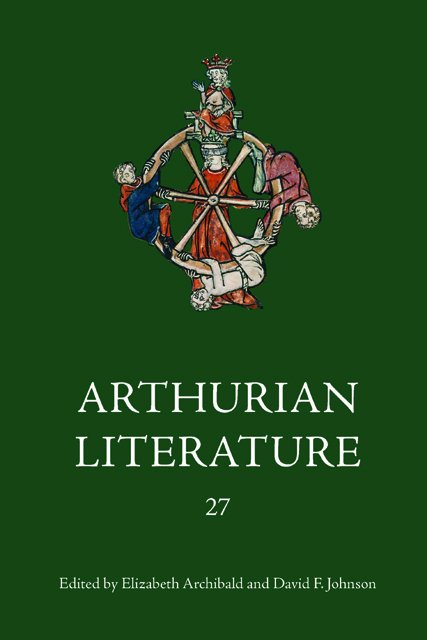Book contents
- Frontmatter
- Contents
- General Editors’ Foreword
- List of contributors
- I Commemoration in La Mort le roi Artu
- II ‘… “if indeed I go”’: Arthur’s Uncertain End in Malory and Tennyson
- III The Intruder at the Feast: Negotiating Boundaries in Medieval Insular Romance
- IV What Women Really Want: The Genesis of Chaucer’s Wife of Bath’s Tale
- V Monstrous Appetite and Belly Laughs: A Reconsideration of the Humour in The Weddyng of Syr Gawen and Dame Ragnell
- VI Speaking (of) Treason in Malory’s Morte Darthur
- VII Lancelot of the Laik: A Scottish Mirror for Princes
- VIII Prince Arthur’s Archers: Innovative Nostalgia in Early Modern Popular Chivalry
- Miscellaneous Endmatter
III - The Intruder at the Feast: Negotiating Boundaries in Medieval Insular Romance
Published online by Cambridge University Press: 18 February 2023
- Frontmatter
- Contents
- General Editors’ Foreword
- List of contributors
- I Commemoration in La Mort le roi Artu
- II ‘… “if indeed I go”’: Arthur’s Uncertain End in Malory and Tennyson
- III The Intruder at the Feast: Negotiating Boundaries in Medieval Insular Romance
- IV What Women Really Want: The Genesis of Chaucer’s Wife of Bath’s Tale
- V Monstrous Appetite and Belly Laughs: A Reconsideration of the Humour in The Weddyng of Syr Gawen and Dame Ragnell
- VI Speaking (of) Treason in Malory’s Morte Darthur
- VII Lancelot of the Laik: A Scottish Mirror for Princes
- VIII Prince Arthur’s Archers: Innovative Nostalgia in Early Modern Popular Chivalry
- Miscellaneous Endmatter
Summary
In 1299 Edward I held a great feast to celebrate his second marriage. The king took the opportunity to organize a recreation of the Round Table with selected knights taking on the roles of Arthurian heroes. When the first course had ended a page called for silence and Edward, in the role of Arthur, declared that he desired to hear news before he ate any more. A blood-spattered squire then entered and accused the court and king of cowardice, calling down a curse on them unless they avenged the treatment he had suffered at the hands of the Welsh. The king and knights pledged to do so. After the second course a bound squire rode in with a letter from the king of ‘Irelant’ for the knight playing the role of Lancelot. The letter challenged the knight to meet him on the coast of Wales. After the third course a loathly lady entered on a nag and told the knight playing Perceval to win the castle at Leicester from its lord, before challenging ‘Gawain’ to put an end to the strife in ‘Cornuaelge’.
The episode is related by the chronicler Lodewijk van Velthem and, although the accuracy of his dating and geographical references has been questioned, it seems almost certain that an event conforming in most respects to that described above did indeed take place. In organizing these entertainments, Edward was drawing upon a literary motif which, even in 1299, had a long and rich tradition. The motif in question is that of the intruder at the feast, who breaks in upon the court to issue a challenge or a call to adventure. The motif pre-dates the appearance of those texts we generally classify as romance, appearing in Irish sources that may be dated as early as the ninth century, but achieves what can only be described as conventional status in medieval Arthurian romance. Yet despite, or perhaps because of, its widespread occurrence it has never received sustained critical analysis.
In dealing with such motifs it is tempting to isolate the section of the text in which the motif appears for purposes of intertextual comparison and neglect the broader narrative context.
- Type
- Chapter
- Information
- Arthurian Literature XXVII , pp. 33 - 58Publisher: Boydell & BrewerPrint publication year: 2010



